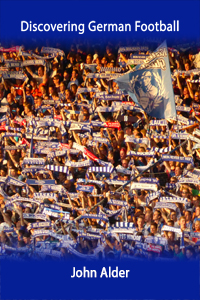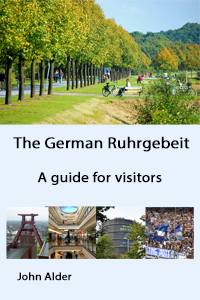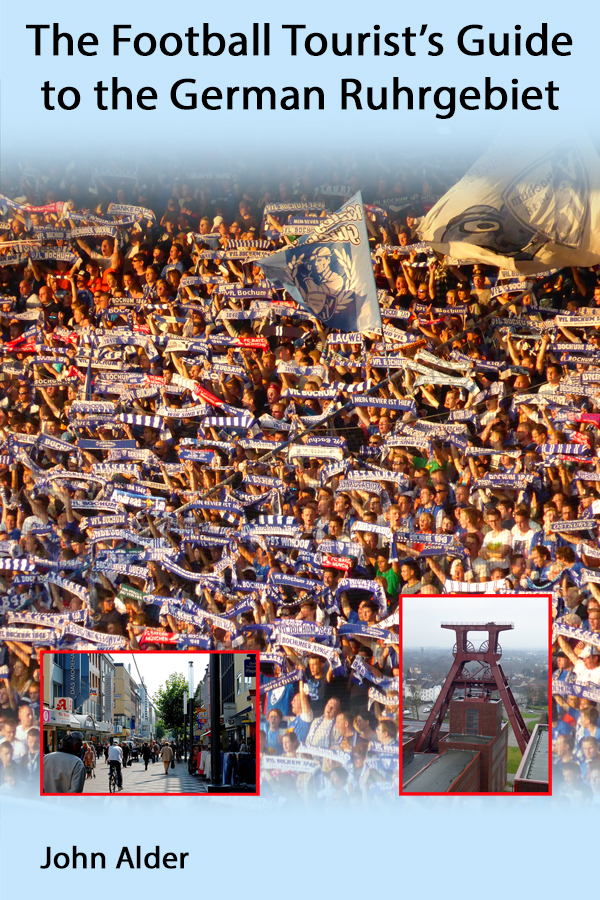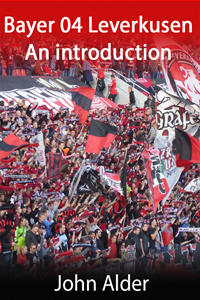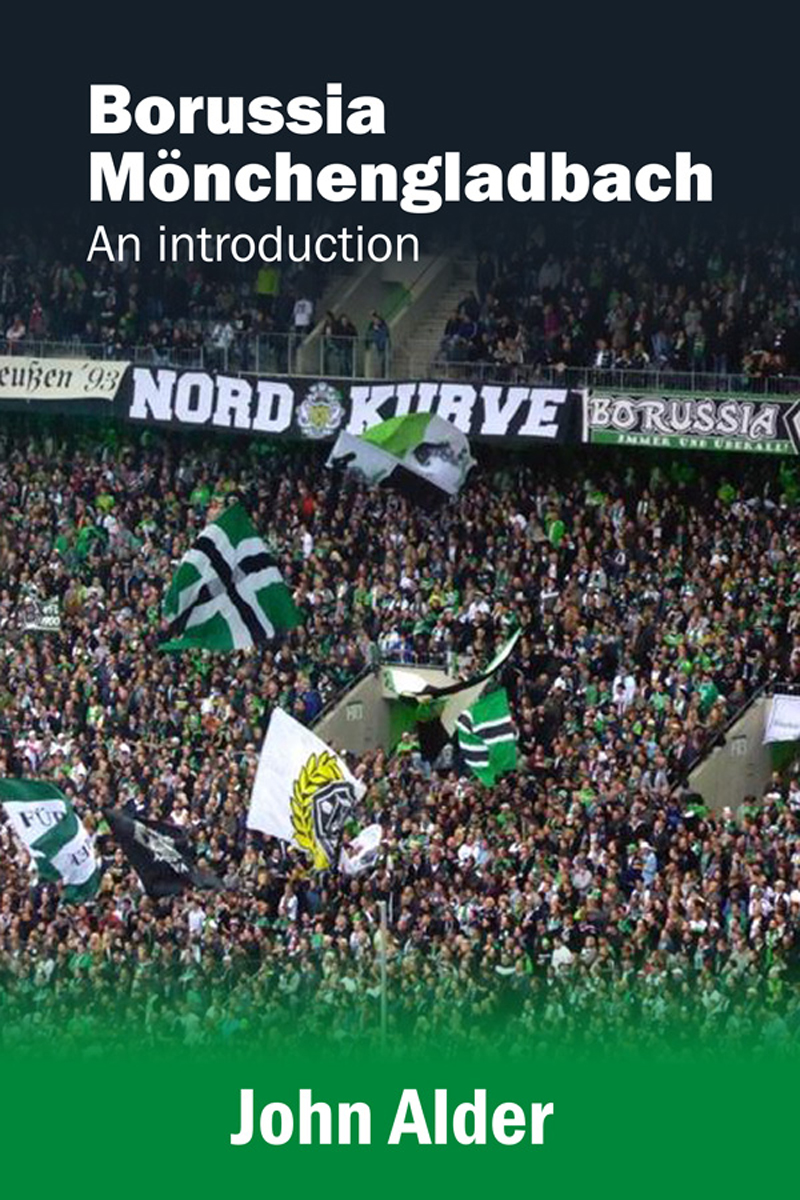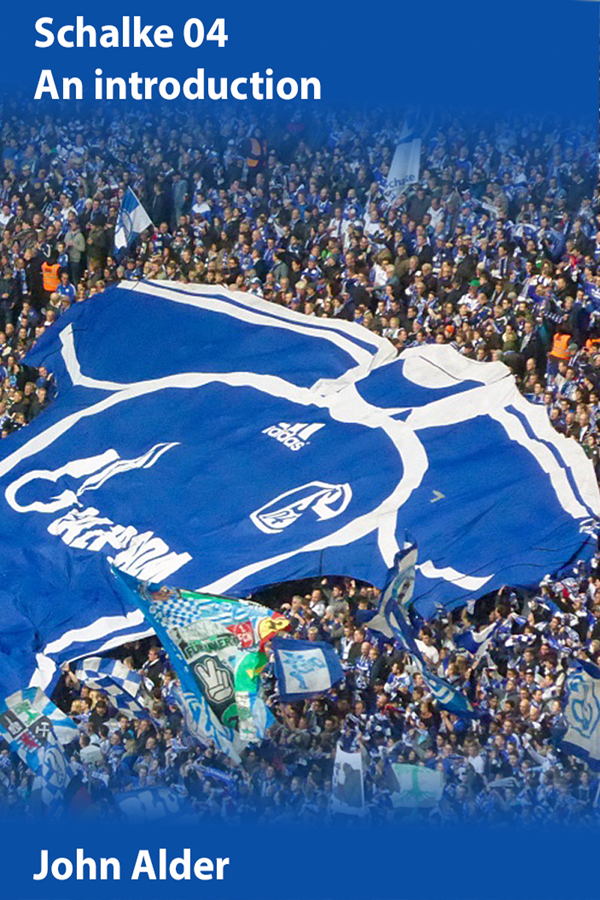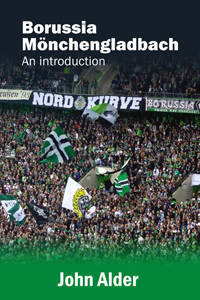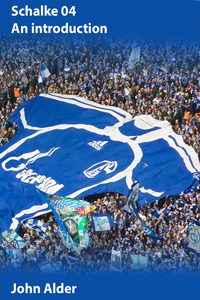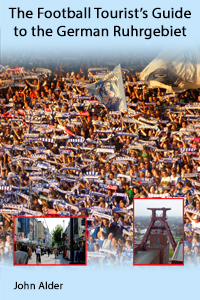It is also perfect either for a city break or a longer stay. Situated beside the Rhine, close to the Dutch border, with Cologne and Bonn to the south and the cities of the Ruhr to the north, Düsseldorf is also the ideal starting point for an exploration of the region.
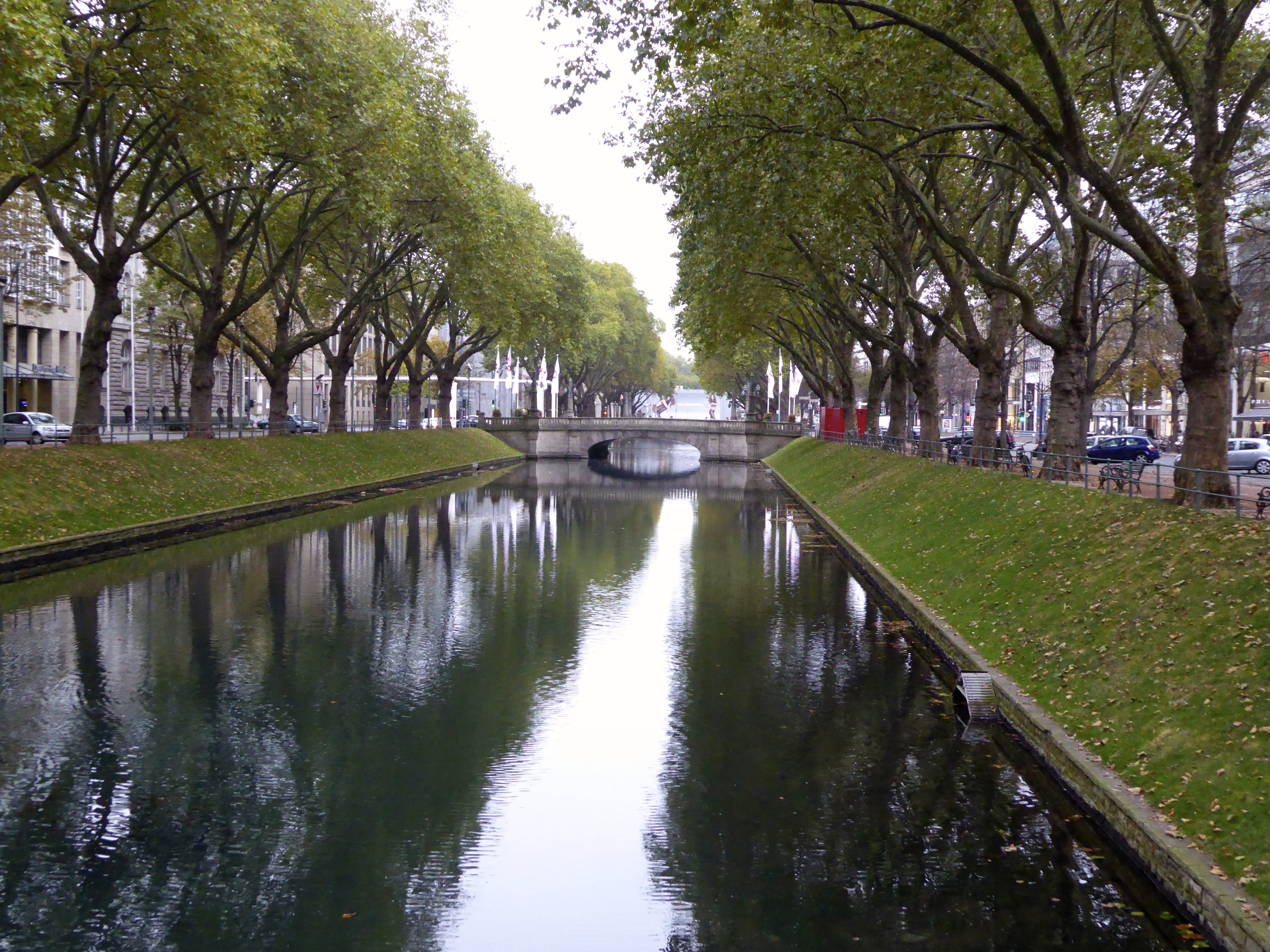
This post is not a detailed tourist guide. But I do hope it will convince you to come and visit this lovely city and help you to get the most out of your stay.
How do I get to Düsseldorf?
Plane
Reaching Düsseldorf by air is very straightforward. The airport is 5 miles from the city centre and there flights to and from a wide range of cities in Germany, Europe and beyond. The airport website has detailed information on airlines and destinations.
Düsseldorf airport is a lovely place to arrive at. It is light, modern, clean and well-equipped with cafes, restaurants, and shops.
There are two very quick routes into town.
- The S11 train, which departs every three times every hour from a platform directly below the terminal building, will bring you to the city centre in 15 minutes.
- An elevated railway called the Sky Train links the arrival terminals to the nearby airport station. From here you can catch trains to a wide range of destinations, including the city centre. There are ticket machines on the platforms, but there if you need advice, there is also a ticket office.
Train
Düsseldorf is a major hub of the German rail system. More than 1000 trains arrive here every day, and you can get here by train from all over Europe. There is a journey planner on the Deutsche Bahn website.
Car
The city is also well served by Germany’s motorway network. You can use the A46 from the east and the west, the A4 from the north and the A57 from the south to get here. The main German motoring organisation is called ADAC. You can use its website to plan your journey.
How do I get around in Düsseldorf?
Getting from A to B is one of the pleasures of a stay in Düsseldorf. The city has a modern, quick and reliable public transport system which is fully integrated, allowing you to use the same ticket for trains, underground, trams and buses. Maps and information displays at every stop and on every platform help you to plan your journey and electronic displays and announcements make sure you know when to get off. Some of the trams and underground trains have instructions in English.
An organisation called VRR co-ordinates public transport in the region. Its website contains very helpful advice in English about how the system works and how to plan your journey.
You can also download the VRR App for your iPhone or Android.
Save money with the DüsseldorfCard
The cheapest way to get to know Düsseldorf is to buy a DüsseldorfCard. It entitles you to free travel on public transport within the Düsseldorf City area as well as free or reduced entry to a wide range of attractions and museums. A ticket for one person costs 9.00, 14.00 or 19.00 euros for 1, 2 or 3 days respectively. A family ticket (2 adults and 2 children, or 3 adults) costs 18.00, 28,00 and 30,00 euros. You can find out more here.
Clubs to see on a football trip starting from Düsseldorf
These clubs are all easy to get to:
2 Bundesliga
Regionalliga West
Fortuna Düsseldorf
We all know famous, well-supported and once-great clubs that have now fallen on harder times. The loyal, long-suffering fans of these sleeping giants still remember former triumphs and dream that one day their club will be back where it deserves to be. Now and then a strong start to the season, a string of good performances or the emergence of a talented player re-ignite the hope that this will be their year. Fans learn to live from a diet of mid-table mediocrity spiced up by occasional battles against relegation and runs for promotion. But the size of the club and numbers and passion of its fans lead everyone to think it could and should be doing better than this.
Fortuna Düsseldorf is just such a club. It was founded in 1895. And in the 1920s and 1930s was one of the top sides in Germany, winning the league and cup as well as providing players for the national side. In the 1970s and 1980s, it became a household name once more, achieving 16 years in the Bundesliga, two cup final wins, and a series of international appearances. But since the 1980s Fortuna has been what the Germans call an elevator side, moving up and down the leagues. At one point they fell as far as the fourth division before climbing right back to the top tier and were last in the Bundesliga in the 2012/13 season.
But Fortuna fans have stayed loyal through the bad times as well as the good. 12,000 fans bought season tickets at the beginning of the 2017/18 season and average attendance was 28,838 – third highest in the division.
And this loyalty was rewarded. On the last day of the season, Fortuna beat 1 FC Nürnberg to become second division champions and earn automatic promotion back to the Bundesliga.
Top level football had returned to the ESPRIT Arena.
Fortuna Düsseldorf at a glance
Website: www.f95.de/home/
Facebook: www.facebook.com/fortunaduesseldorf/
Twitter: twitter.com/f95
Email: service@f95.de
Telephone: +49(0)211 238010
Online Ticket Shop: tickets.f95.de/f95
Ground: ESPRIT Arena
Capacity: 54,600
Address: Arena-Straße 1, 40474 Düsseldorf
Colours: Red white
Nickname: Die Flingeraner (Flinger is the district of Düsseldorf where the club was founded)
Borussia Mönchengladbach
It will take you about 90 minutes to get to Mõnchengladbach – a large town not far from the border with Holland. The most notable thing about this place is its football team – Borussia Mönchengladbach. This club dominated German football in the 1970s. Its players were amongst the first sporting superstars and their adventurous style of play captivated fans in Germany and beyond. Today Borussia is the third best-supported team in Germany, with gates of over 50,000 every week and over 70,000 members. The fans inside the Borussia Park stadium generate an atmosphere that is guaranteed to raise the hairs on the back of your neck.
Many games are completely sold out, so it’s a really good idea to buy tickets before you come to Germany. This will also save you money as your ticket entitles you to free match day travel to and from the ground on local transport.
These are the best ways to get hold of tickets:
• Use the online ticket shop. Although everything is in German, the ticket portal is easy to use.
• Call the ticket hotline (0039 1806 181900). There will always be someone who can speak to you in English and advise you on the best place to sit.
• Send an email to the club explaining what you want (info@borussia.de).
BORUSSIA-PARK is a long way from the city centre, but getting there is not a problem. On match days, a fleet of shuttle buses transport fans from behind Mönchengladbach station to the ground. The same service also operates from nearby Rheydt station (opposite Platform 4).
I would advise you to aim to arrive well before kick-off. This will give you time to visit the FanHaus and the beer garden.
The FanHaus is just beyond the carparks at the southern end of the stadium. It is run by and for the fans. It has bars, food outlets, TV screens and music as well as indoor and outdoor seating areas. On match-days, it is heaving with fans of all ages eating Bratwurst, drinking beer, singing and chanting. Look out for the Liverpool bar, which celebrates a longstanding friendship between fans of the two clubs.
The beer garden is right next to the ground, in front of the club shop. Next to stalls selling food and drink there are benches and tables where thousands of fans gather before every game.
You can use cash to buy food and drink inside the ground. There are outlets on every level and block selling soft drinks, beer, tea and coffee, as well as a wide variety of fast food including, of course, chips and sausage.
You do need to pay a one euro deposit for your beer glass, which you return at the end of the game. Or you might want to hang onto it. Although made of plastic they are covered with designs and logos and make great souvenirs.
Related post
Going to watch Borussia Mönchengladbach
Borussia Mönchengladbach at a glance
Website: https://www.borussia.de/english/home.html
Facebook: https://www.facebook.com/borussia.global
Twitter: https://twitter.com/Borussia_en
Email: info@borussia.de
Telephone: +49(0) 1805 181900
Online Ticket Shop: https://www.borussia-ticketing.de/default.aspx
Ground: Borussia-Park
Capacity: 54,067
Average attendance 16/17: 51,494
Address: Hennes-Weisweiler-Allee 1, 41179 Mönchengladbach
Colours: Green white black
Nickname: die Fohlen (the foals)
Bayer 04 Leverkusen
Leverkusen is a large town between Düsseldorf and Cologne. For over a century it has been the home of Bayer – the multinational pharmaceutical company. The local football club, founded originally by Bayer employees, is called Bayer 04 Leverkusen. Some people cruelly call this club ‘Neverkusen’ because of its history of just missing out on the big prizes. But many argue that it is one of Germany’s most successful clubs. A member of the Bundesliga every year since 1979, Leverkusen has ended nineteen of those years in one of the top five places. The club has appeared in the Champions League nine times and the Europa League seven times.
A visit to Bayer 04 Leverkusen is also the perfect starting point for people new to Germany and its football culture:
• It is easy to reach by public transport – a 60-minute train journey from Dortmund and a 20-minute walk from the station to the ground.
• It has a spectacular, modern stadium which is designed to bring every spectator close to the action and to maximise the atmosphere.
• The club has one of the most family-friendly set-ups in the Bundesliga.
• The team plays an exciting and highly entertaining brand of football.
The simplest way to get tickets is to call the club’s ticket hotline (0049 214 5000 1904). There is always someone there who can speak English and who can advise you on the best places to sit. You could also use the Online Shop. This way you can choose exactly where to sit and you can use the Print@Home facility to print your ticket before you leave.
Getting to the BayArena could not be easier. There are frequent trains from Düsseldorf to Leverkusen. You just follow the signs at the station for the Sportpark. Then you walk through a park, following the signs for the BayArena, which will appear after about 15 minutes through the trees on your left.
Extensive modernisation and refurbishment in 2007 have turned this stadium into one of the most attractive, comfortable and fan-friendly venues you are ever likely to visit. With a maximum capacity of 30,000, there are enough fans to generate a sense of occasion without it being overwhelming – and the closeness of all seats to the action makes sure everyone gets a good view and maximises the atmosphere.
Inside the stadium, there are all the usual food and drink outlets, a club shop, a creche and free WiFi. If you download the Live-App, you can access live, real-time data about the game.
The only possible complication is that you can’t use cash inside the ground. Instead, you need to get a BayArena card from one of the kiosks once you arrive. You pay a 10 euro deposit and then put as much money as you want onto the card, which you then use for every purchase.
At the end of the game, you go back to the kiosk to get your deposit and any unspent money back.
Bayer 04 Leverkusen at a glance
Website: https://www.bayer04.de/en-us/
Facebook: https://www.facebook.com/bayer04leverkusen
Twitter: https://twitter.com/bayer04fussball
Email: info@bayer04.de
Telephone: +49(0) 214 5000 1904
Online Ticket Shop: https://ticketshop.bayer04.de/SpielAuswahl
Ground: BayArena
Capacity: 30,210
Average attendance 16/17: 28,428
Address: 122, 51373 Leverkusen
Colours: Red black
Nickname: die Werkself (works eleven – because of links to local pharmaceutical firm Bayer)
Borussia Dortmund
According to Forbes Borussia Dortmund is the 11th most valuable football club in the world.
It has well over 100,000 members, making it one also one of the best supported. With an average of over 80,000 the club has the highest attendance in the Bundesliga.
There are 55,000 season ticket holders, and there is waiting list of 10,000.
The club has been in the Bundesliga for 49 years and ranks third in the all-time table.
Dortmund is still owned and heavily influenced by its fans. It could make more money by replacing some places for fans with hospitality boxes and by raising prices – but the club refuses to do this. Instead, it is determined to live within its means and to bring out the best in the players already in the squad, rather than buying success on the international transfer market. It has invested heavily in its academy, which regularly produces high-quality players.
In recent years Dortmund teams have become renowned for their playing style which is characterised by passion, hard work, technical quality, high-pressing and quick transition from defence to attack.
They have been the only club to come close to challenging Bayern Munich for dominance of German football. In 2015/16 they remained contenders until the second to last game of the season. Up to 1,000 English fans take budget airline flights each match day to Dortmund to see a game the Signal Iduna Park. And they come back buzzing from the experience. If you get the chance, go and experience for yourself the noise and passion of the yellow wall of fans standing behind the home goal.
The Signal Iduna Park is one of the best known and most beautiful stadiums in the world, and with a capacity of 81,719, it also one of the biggest.
But it is the fans who make a visit to the Signal Iduna Park one of the most exciting and awe-inspiring experiences you can have in football.
The Südkurve, which has places for 25,000 fans, is the largest standing section of any ground in Germany. This is where you will see the famous ‘Gelbe Wand’ – Yellow Wall – where row after row of passionate fans, all dressed in the club’s colours shout, cheer, chant and sing their support from start to finish. Although the Südkurve is the loudest and most passionate section of the stadium, the entire crowd gets behind the team. Visiting teams have to not only play against one of the top teams in Europe but also in a cauldron of emotion.
BVB could easily fill the stadium with season tickets, probably even if they put up prices. The club could also generate more money by reducing the number of seats and installing more boxes for corporate entertainment. But true to BVB’s fan-focussed ethos, the stadium is designed to fit in as many fans as possible, prices are kept relatively low and a proportion of tickets are kept for general sale each week.
The stadium is about 3 kilometres from the city centre, but it’s easy to get there by public transport. It has its own station where local trains arrive every 15 minutes (look out for RB52 and RB59). Or you can take the underground (U45) to the stop ‘Westfalenhallen’ and walk the last five minutes.
Tickets for all BVB games sell out very quickly, so you should arrange your tickets well before you set off. You can get tickets online and use Print@Home to print your ticket before you set off. The club also offers an attractive package which includes ticket and two nights in a hotel for 209.00 euros per person.
A standing place (if you can get one) will cost you 16.70 euros. Prices for seats start at 31.20 euros. There might be a 20% surcharge for games against Bayern Munich and – of course – FC Schalke 04.
You can’t use cash inside the stadium. Instead, you need to get hold of a Stadiondeckel from one of the many operatives inside the stadium. You tell them how much cash you want to load onto it and then use it as a debit card whenever you buy anything to eat or drink. After the game, you can get back any money you have not yet spent.
There is free wi-fi in the stadium and if you download the BVB-App, you can get stories, background information and live data before, during and after the game.
Related post
Borussia Dortmund at a glance
Website: http://www.bvb.de/
Facebook: https://www.facebook.com/BVB
Twitter: https://twitter.com/bvb
Email contact form: https://www.eventimsports.de/ols/bvb/de/bundesliga/channel/shop/index/contact
Telephone: +49 (0) 1806 51 5304
Online Ticket Shop: https://www.eventimsports.de/ols/bvb/
Ground: Signal Iduna Park
Capacity: 81,359
Average attendance 16/17: 79,653
Address: Sportweg, 44139 Dortmund
Colours: Black yellow
Nickname: BVB
1 FC Köln
1 FC Köln was founded in 1948 when two other clubs (Kölner Ballspiel Club 1901 and SpVgg Sülz 07 merged)
Thirty years of success
From the 1960s to the early 1990s they were one of Germany’s most successful clubs.
After winning the Oberliga West for three successive seasons and playing in Europe in 1962/63, Köln were selected to play in the newly formed professional Bundesliga in 1963 – and in fact were the first champions.
They were second in 1964/65 and won the cup in 1967.
The 1970’s saw FC Köln reaching three cup finals, losing three but winning in 1977.
1977/78 was the club’s most successful season – they emerged as champions and retained the cup.
They won the cup for a fourth time in 1983, reached their first European final in 1986 (losing to Real Madrid) and finished second in the Bundesliga in 1988/89 and 1989/90 and were losing cup finalists in 1991.
Mixed fortunes
Since the early 1990s , the club has experienced many ups and downs. Relegated to the second Bundesliga in 1998, they have moved regularly between the two top tiers for the last twenty years.
The club ended the 2013/14 season as worthy 2 Bundesliga champions and was promoted back to the Bundesliga and then enjoyed three successful years at the top tier finishing 12th, 9th and 5th. Qualification for the Europa League in 2017/18 meant that Cologne fans saw international football for the first time in 25 years. Unfortunately, their high hopes were soon dashed. Despite a change of manager and unwavering support the team failed to recover from a disastrous start to the season and was relegated to the 2 Bundesliga.
Honours
German Champions
Winner (3): 1961/62, 1963/64, 1977/78, ,
Runners-up (7): 1960, 1963, 1965, 1973, 1982, 1989, 1990
2 Bundesliga
Winner (3): 1999/00, 2004/05, 2013/14
Runners-up (1): 2003
German Cup (DFB Pokal)
Winner (4): 1968, 1977, 1978, 1983
Runners-up (6): 1954, 1970, 1971, 1973, 1980, 1991
UEFA Cup
Runners-up (1): 1986
Florida Cup
Winners 2015
Nickname and mascot
The clubs nickname is die Geißböcke, which means the billy goats.
Their mascot is also a billy goat – and always called Hennes after Hennes Weusweiler who was a long serving player and manager.
The fans refer to their team simply as FC (pronounced, and sometimes written Effzeh)
Local rivals
Borussia Mönchengladbach
Bayer Leverkusen
Fortuna Köln (currently two divisions further down
Fortuna Düsseldorf(currently one division further down)
Colours : Red and white
Famous names
Rainer Bonhof
Dieter Müller
Toni Schumacher
Bernd Schuster
Lukas Podolski
Pierre Littbarski
Stadium
FC Köln play at the Rheinenergie Stadion on Aachener Strasse.
Thoroughly renovated in 2003, it has a capacity of 50000. Like a lot of British grounds, it is designed so that spectators are close to the pitch, which makes for a hugely exciting atmosphere.
If you have the time, you might want to take a look at the FC Museum, which sets out the club’s sixty year history.
Tickets
You can buy tickets online and have them sent to you at home. The ticket shop website is in German, but is very straightforward.
You can also buy tickets at the stadium before the game.(but of course local derbys and games against the very top teams are likely to sell out quickly).
Prices are between € 16 and € 63.
Away fans sit behind the goal on the North Side.
Directions
On matchdays there are special trams which will take you directly from Cologne station and Neumarkt to the stadium.
You can also get there by yourself if you want :
From Cologne station, take the underground (U16 or U18) to Neumarkt, and then the tram (No. 1 – going to Weiden West) to a stop named after the stadium – RheinEnergie Stadion.
Your match ticket will entitle you to free travel to and from the ground.
1 FC Köln at a glance
https://fc.de/fc-info/home/?L=2
Telephone: +49 (0) 221/260 11 221
Tickets: https://www.eventimsports.de/ols/fckoeln/de/bl/channel/shop/
Nearest airports: Cologne/Bonn, Düsseldorf
Local transport:
https://www.vrsinfo.de/englisch/the-vrs/vrs-about-us.html
Ground: Rhein-Energie Stadion
Capacity: 50,997
Average attendance 18/19: 49,547
Address: Aachener Straße 99, 50933 Köln
Colours: Red white
Nickname: Die Geißböcke (the billy goats)
SC Paderborn
The British Army of the Rhine once had a huge barracks at Paderborn, and over the years thousands of young Brits have gone to SC Paderborn 07 for their football while away from home.
The club can trace its roots rights back to 1907 when one of its many predecessor clubs was founded. The club we know today was formed in 1985 following a merger of two local sides and adopted its current name in 1997. Between then and 2005 Paderborn played in regional leagues and for the last 12 years, apart from one season in the Bundesliga, has moved between the 2nd and 3rd divisions.
Last year the club came very close to making history as the first football club to drop from the Bundesliga to the fourth division in three successive seasons. Having earned promotion to the Bundesliga for the first time in 2013/14 Paderborn endured a miserable season in the top division, finished bottom and dropped straight back into the 2 Bundesliga. In 2015/16 the misery continued, and Paderborn came bottom again. A third successive relegation in 2016/17 was avoided despite finishing in 18th place yet again because 1860 München, having been relegated from 2 Bundesliga, failed to meet DFB financial deadlines. As a result, the Bavarian club was refused a professional licence and put into a Regionalliga. This allowed Paderborn to hang onto league status.
The Benteler-Arena was opened in 2008. It has a capacity of 15,000, with 5,800 seats and 9,200 standing places. All parts of the ground are covered.
Standing tickets cost 10 euros and seats cost between 20 and 27 euros. You can buy them at the Online Ticket Shop and at the club shop.
You can get to Paderborn from the main Ruhrgebiet cities in about 2 hours. The cheapest way to travel is to buy a Schöner Tag Ticket. It costs 30 euros for one person and 44 euros for up to five. It lets you travel for a whole day (after 9 am) right across North Rhine-Westfalia and on any train except Intercity, EC and Thalys.
Your match ticket entitles you to free local bus travel from the town centre to the stadium. The number 68 towards “Schöne Aussicht” will take there from the station in about 15 minutes. You get off at “Arena/Almeaue”.
SC Paderborn at a glance
Website: http://www.scp07.de/
Facebook: https://www.facebook.com/meinSCP
Twitter: https://twitter.com/SCPaderborn07
Email: info@scpaderborn07.de
Telephone: +49(0) 5251 8771907
Online Ticket Shop: https://www.eventimsports.de/ols/scp07/
Ground: Benteler Arena
Capacity: 15,000
Average attendance 16/17: 5,541
Address: Paderborner Straße 89, 33104 Paderborn
Colours: Black white blue
FC Schalke 04
Do you want to see top quality football played with skill, passion and commitment in front of a capacity crowd in one of the best stadiums in the world?
Do you want to visit a football club which is proud of its long and distinguished history?
Do you want to sit or stand amongst 61,000 real fans who know their football?
Do you want to be part of an amazing sporting spectacle?
If you answered yes to any of these questions, then FC Schalke 04 is the ideal Bundesliga destination for you.
Schalke 04 is one of the oldest, biggest and best-known clubs in the Bundesliga. It is also one of the most successful. Seven times German champions, Schalke has won the German Cup five times and the UEFA Cup once.
The Veltins Arena is without a doubt one of the finest stadiums in the world.
It opened in 2001 and quickly established itself as a first class entertainment venue. Fans have flocked here to see top music acts like U2, Robbie Williams and Bruce Springsteen, sporting events such as the 2010 World Ice Hockey Championships and boxing – as well as football, of course.
It can accommodate 61,973 football fans. There are 16,307 standing places, giving the club the second largest standing area in the Bundesliga. There is a retractable roof, and withdrawable pitch and all seats provide a fantastic view of the action. As you would expect, facilities and food outlets are also of a very high standard.
You will not go hungry or thirsty at the Veltins Arena. According to the club’s website, there are 15 small restaurants, 50 grilling stations and 35 cafes – all connected by a 5km long beer pipe. On a typical match day, they will sell 14,000 sausages, 43,000 rolls, 40,000 litres of drink.
Getting there from the city centre is very straightforward. You go out of the station, down some steps to the underground and catch tram 301. Your stop is conveniently called ‘Veltins Arena’, and your destination is about five minutes away.
The stadium stands on its own and out of town, so you would think that there would not be much to do before the game. But the club has gone to great lengths to cater for fans who arrive early. There are kiosks selling food and drink on all the walkways to the ground. Beyond the training grounds – which are open to the public – there is a huge fan shop and a bar/restaurant. As a result, you are likely to see thousands of fans in the area two or three hours ahead of kickoff.
There is a cashless payment system throughout the arena. While this is extremely convenient for regular fans and reduces delays when buying food and drink, it can be a bit daunting for the one-off visitor from overseas. Using the system, however, is very straightforward. When you get inside, go to one of the countless kiosks issuing ‘Knappenkarten’. The card is free, and you can load on as much money as you are likely to spend. When you want to buy something you hand over your card and then say what you want. They will then take the cost from your card. If you don’t spend all your money, you can get a refund before you leave.
Going home is not quite a simple as arriving. Although extra trams and buses are laid on, moving 60,000 people is time-consuming, and so it can take you a while to get back to the town centre. Similarly, Gelsenkirchen station and departing trains can be crowded for a while after games.
My advice would be not to rush home. If you can, stay for a drink or two after the game. Stop off for something to eat in the city centre before catching your train.
Before every game, the entire stadium stands and sings along to the miners’ anthem: ‘das Steigerlied’. At the same time, black and white footage of mining scenes is shown on the big screen. This moving tribute to those who have gone before will give you goosebumps. The song dates back to the 16th century and is sung in mining areas all over Germany, as well as at political rallies. It’s about miners preparing for a long hard shift and hoping to get back to the surface safely. It starts and ends with the traditional miners’ greeting of ‘Glück auf’.
Related post
FC Schalke 04 at a glance
Website: http://www.schalke04.de/en/
Facebook: https://www.facebook.com/S04.en
Twitter: https://twitter.com/s04_en
Email: kundenservice@schalke04.de
Telephone: +49 (0) 180 622 1904
Online Ticket Shop: https://store.schalke04.de/tickets/schalke-04-spiele/heimspiele/
Ground: Veltins-Arena
Capacity: 62,271
Average attendance 16/17: 60,703
Address: Arenaring 1, 45891 Gelsenkirchen
Colours: Blue white
Nickname: die Königsblauen (the royal blues), die Knappen (the miners)
VfL Bochum
Like many German football clubs, VfL Bochum 1848 proudly carries the date of its birth in its name. Although it’s not quite a straightforward as it would at first appear, the club’s name and history are intertwined. In 1848 a gymnastics club called Turnverein zu Bochum was formed. The new club was then banned for political reasons in 1852 and re-established in 1860. In 1904 the date of its birth was added to the club name and football was first played in 1911. There was another name-change in 1924 to Turn-und Sportverein Bochum 1848, before all three Bochum sports clubs were re-organised by the Nazis into a club called VfL Bochum. In 1949, over one hundred years after the first sporting organisation was formed, the football section was defined as a separate entity carrying its current name VfL Bochum 1848.
The 30,000 seater Vonovia Ruhrstadion is designed so that spectators are as close as possible to the action and no seat is more than 30 metres from the pitch. This creates an intense atmosphere.
Apart from local derbies, games are rarely sold out, so you can probably get a ticket on the day. If, like me, you like to plan ahead, use the Online Ticket Shop. You can choose and pay for your seat and even print out your ticket before you leave home. You can also get a ticket at the tourist information office at Huestraße 9. There will be someone there who can speak English and who can advise you on where best to sit.
Another advantage of getting a ticket ahead of the game is that your ticket entitles you to free travel on public transport to and from the ground.
Getting there is straightforward. From Bochum central station you take an underground train (U308), which soon goes overground, and get off at the stop called Vonovia Ruhrstadion. The stadium is across the road. It is worth getting there well before kickoff. The area around the ground is usually teeming with fans well before it opens, meeting friends, eating sausage or drinking beer.
Before going inside take a walk to the back of the stadium. There is a covered area with catering outlets and a shop. Images of miners and pitheads on flags, scarves and souvenirs point to the town’s history. Interestingly, unlike most German football fans, you will see quite a few people wearing scarves celebrating good relations with Bayern Munich. You might well also see a few Leicester City scarves, as there has been a link between the two sets of fans for over ten years.
VfL Bochum 1848 at a glance
Website: http://www.vfl-bochum.de/site/start_en.htm
Facebook: https://www.facebook.com/meinVfL/
Twitter: https://twitter.com/vflbochum1848ev
Email: info@vfl-bochum.de
Telephone: +49 (0) 235951848
Online Ticket Shop: https://eventimsports.de/ols/vflbochum1848/
Ground: Vonovia Ruhrstadion
Address: Castroper Straße 145 44791 Bochum
Capacity: 29,299
Average attendance 16/17: 16,933
Colours: Blue and white
Nickname: die Unabsteigbaren (those that can’t be relegated)
VfL Osnabrück
The full name of this old club is Verein für Leibesübungen von 1899 e.V. Osnabrück. Its story started in 1899 when a number of “wild” clubs came together to become Fußball Club 1899 Osnabrück. The club’s early history is a complicated story of mergers, splits and name changes – and the current name first appeared in 1925.
After the war, the club was placed in Oberliga Nord where it did well in a league which also contained Hamburger SV, Werder Bremen and FC St Pauli. When the Bundesliga was formed in 1963, Osnabrück joined the second tier Regionalliga Nord and then the 2. Bundesliga. Despite coming close on several occasions, the club was never able to gain promotion to the Bundesliga.
In 2009 VfL Osnabrück was relegated to the 3. Liga where it has remained for the last eight seasons.
The Bremer Brücke first opened in 1931, but it has been refurbished a number of times and thanks to a recent expansion now has a capacity of 16,667 with 10,475 standing places. A standing ticket costs 11 and a seat between 25 and 29 euros.
There is an online shop and you can also order tickets by phone (49180301899) and at the Tourist Information Office on Bierstraße. There are two Fan Shops – one at the stadium and one on Krahnstraße. They also sell tickets.
Osnabrück is just about within reach of Düsseldorf – it will take you about two and a half hours to get there, with one change. The cheapest way to travel is with the SchönerTag Ticket – 30 euros for one person and 44 euros for up to five travellers and valid for a whole day from 9 am on trains (except for IC and EC), trams, buses and underground right across North Rhine-Westfalia. Plan your journey on the VRR website.
Bus numbers 91, 92, 31, 32, 33, 81, 82 will all take you from the station to the Bremer Brücke.
VfL Osnabrück at a glance
Website: http://www.vfl.de/
Facebook: https://www.facebook.com/VfLOsnabrueck
Twitter: https://twitter.com/vfl_1899/
Email: info@vfl.de
Telephone: +49(0) 541 770870
Online Ticket Shop: https://www.lms-ticket.de/vfl-osnabrueck/ajax.aspx?sub=Home
Ground: Osnatel Arena
Capacity: 16,667
Average attendance 16/17: 9,231
Address: Scharnhorststraße, 49084 Osnabrück
3. Liga
Whenever I am in Germany, I try to take in at least one 3. Liga game before or after a Bundesliga encounter. It’s a very different experience, but I have never been disappointed.
The crowds are smaller. This makes it easier to get a ticket. For most games at most clubs, you can pay on the day. The smaller scale means stewards and officials are more relaxed, helpful and welcoming. And of course, you don’t have to wait for as long for food and drink or waste half-time queuing for the toilets. Not having to use public transport with 50,000 others makes arriving and leaving much simpler.
Many 3. Liga grounds are either new or recently refurbished, so facilities are usually excellent. Food and drink is cheaper and often of better quality than in bigger outfits. Most stadiums have more standing places and you feel much more involved.
These clubs are within range of Düsseldorf.
MSV Duisburg
Real football fans are loyal and true and stick with their team through the bad as well as the good times. They don’t defect to other clubs in search of glory. They keep coming back year after year. Each new season begins with the expectation of better things to come, and each game with the hope of a good performance.
The followers of MSV Duisburg are most definitely real football fans. They have had precious little to celebrate for years, and they have had more than their fair share of bad times.
Their club – nicknamed the Zebras after its blue and white striped kit – was once a force to be reckoned with. But since the 1980s, fans have endured the torture of following one of German football’s ‘elevator’ sides up and down the divisions. And yet they still come in their thousands each week to get behind their team.
MSV Duisburg plays in the snappily named Schauinsland-Reisen-Arena, which opened in 2005. It has a capacity of 30,000, including 7,000 standing places, cost 43 million euros to build and is one of the most modern venues in Germany.
Games are rarely sold out, so you can usually get tickets on the day. You can also order tickets in advance from the online shop and then use the Print@home facility to print them before you set off. The online shop is unfortunately only in German, but it’s easy enough to work your way through. You can also get a ticket at the Ruhr Visitor Centre in the town centre (in CityPalais on Königstraße). Standing tickets cost 11 euros and seats from 15 euros. Your ticket entitles you to free travel on public transport (except intercity trains) to and from the game.
Travelling to see MSV not difficult. The 934 bus will take you from Stop 5 outside the station and drop you off right in front of the stadium.
The S1 train between Dortmund and Solingen stops at a local station called DU Schlenk Bf, which is only ten minutes walk away.
MSV Duisburg at a glance
Website: https://www.msv-duisburg.de/
Facebook: https://www.facebook.com/MSV.Duisburg/
Twitter: https://twitter.com/MSVDuisburg
Email: info@msv-duisburg.de
Telephone: +49(0) 20393100
Online Ticket Shop: https://www.eventimsports.de/ols/msv/
Ground: Schauinsland-Reisen-Arena
Capacity: 31,500
Average attendance 16/17: 14,174
Address: Margaretenstraße 5-7, 47055 Duisburg
Colours: Blue white
Nickname: Die Zebras
Preußen Münster
300,000 people live in Münster – and 50,000 of them are students. It’s an old, historic city that was founded in the early middle ages and its rich history is reflected in its many old buildings.
Münster claims to be Germany’s bicycle capital. The bicycle is the most common way for residents to get around and there is a car-free ring around the city centre. The city also recently won an award for being one of the nicest places to live in the world.
SC Preußen 06 Münster was founded in 1906 and was a founding member of the German Bundesliga when it was formed in 1963. The club’s greatest achievement was to come second in the German championship in 1951. In recent years Preußen Münster has struggled with financial difficulties and inconsistent performance and for a time they dropped out of the professional leagues altogether. Recent improvements have led to promotion to the 3. Liga in 2011 and steady top-half finishes every year.
They play in the Preußenstadion and last season achieved a highly respectable average attendance of 7,220.
Games are rarely sold out, so you can probably get a ticket on the day. If you like to plan ahead, use the Online Ticket Shop.
A standing ticket costs 12.80 euros. Seats cost between 20.50 euros and 24.90 euros. Unless you really need to sit during the game, I would advise you to buy a ticket for Block L. This is the most popular area of the ground, so you will get the chance to stand amongst lots of very vocal fans. At the same time, you will be able to see and hear the hard-core fans behind the goal.
You can get to there by bus (1, 5 and 9 from the station to “Preußenstadion”), but it’s just as easy to go on foot.
As you leave the station follow the signs for the Altstadt. After about five minutes you will reach a wide tree-lined path which runs around the town centre. Turn left here and follow the path until you reach a roundabout. Take the third exit onto Hammer Straße and just keep walking until you get to the stadium.
When it was built in 1926, this was one of the most modern in Germany. Although the club is implementing a programme to bring it up to date, this is most definitely not the case today. But in my opinion, that is why it’s such a great place to experience German football.
If you prefer a bit of comfort and protection from the weather, there is a covered seated section along one side of the pitch (Blocks A to F). The opposite stand (Blocks K and L) is also covered, but standing only. This section gets really full and generates a great atmosphere. The hard-core fans gather behind the goal in Blocks M, N and O. This section is not covered.
There is an open space just inside the stadium which contains stalls selling very reasonably priced food and drink. This is a great place to have a Bratwurst and a beer before the game. There are also outlets behind the stands on either side of the pitch.
Preußen Münster at a glance
Website: http://www.scpreussen-muenster.de/
Facebook: https://www.facebook.com/scpreussen
Twitter: https://twitter.com/Preussen06
Email: info@scpreussen-muenster.de
Telephone: +49(0) 251 987270
Online Ticket Shop: https://www.eventimsports.de/ols/scpreussen/
Ground: Preußenstadion
Capacity: 15,000
Average attendance 16/17: 7,075
Address: Hammer Straße, 48153 Münster
Colours: Black white green
Nickname: Preußen
Colours: Purple white
Nickname: Lila-Weiß (the lily whites
Regionalliga West
Below the 3. Liga German football is divided into regional leagues. Regionalliga West is the one nearest to Düsseldorf and contains several interesting clubs.
Rot-Weiß Essen
Rot-Weiß Essen (or RWE) is the classic Ruhrgebiet football club, and its history is inextricably linked to that of the region.
Founded next door to a mine, right in the middle of Germany’s industrial heartland the club had a ready supply of fans wanting a distraction from their tough daily lives, and a steady stream of young men who saw football as the only alternative to life down the pit or in the steelworks. As a result, RWE flourished in the first half of the 20th century.
The club’s fall since the 1960s mirrors the decline of traditional heavy industries in the Ruhr region and the accompanying economic, social and cultural changes.
In recent years the club has faced daunting financial problems and has languished in the shadow of bigger neighbours like Schalke 04 and Borussia Dortmund. The 1953 Cup Winners and 1955 Champions now play their football in the fourth-tier Regionalliga West and relegation is a constant worry.
But like many across the region, RWE fans remain loyal to their club. They are proud of their heritage and doggedly determined to achieve a better future. They cheer on their club in a brand new stadium built in partnership with the city.
Their motto is:
RWE war wer – RWE ist wer – RWE bleibt wer!
(RWE was special – RWE is special – RWE will always be special)
Stadion Essen is one of the nicest venues to watch a game of football. It’s brand new and has a capacity of 20,650, including 9,040 standing places. The ground is very compact and comfortable. Wherever you sit or stand, you have a clear view and are close to the action on the pitch. Prices for food and drink are very reasonable – you will get a beer and a Bratwurst for under 5 euros.
Standing places cost 10 euros and seats up to 18 euros. You can buy them on the day or order ahead with the online ticket shop. The site is in German but working your way through it is straightforward. It will cost you an extra 6.90 euros to have them sent to your home address.
The simplest way to get there is by train. Take any train from Düsseldorf to Duisburg, where you change onto the S2 towards Dortmund. You get out at Essen-Bergeborbeck, and it’s then a short walk to the ground. There are also plenty of buses and a tram (SB16) from Essen station.
Rot-Weiß Essen at a glance
Website: http://www.rot-weiss-essen.de/start/
Facebook: https://www.facebook.com/Rot.Weiss.Essen1907
Twitter: https://twitter.com/Rot_Weiss_Essen
Email: info@rot-weiss-essen.de
Telephone: +49 (0)201 – 86 144 0
Online ticket shop: https://www.lms-ticket.de/rot-weiss-essen/ajax.aspx?sub=shop&id=65dfb51a-6747-4eee-8a1f-aeaf914e3753
Ground: Stadion Essen
Capacity: 20,650
Average attendance 2016/17: 7,865Address: Hafenstraße 97A, 45356 Essen
Colours: Red white
Alemannia Aachen
Aachen’s history dates back to the early middle ages and for many years it was the home of the German kings who ruled the Holy Roman Empire. It is also home to Alemannia Aachen. Founded in 1900, it is one of Germany’s oldest football clubs. The club currently plays in the fourth-tier Regionalliga West (finishing 7th in 2016/17). Despite its relatively lowly status, Alemannia Aachen has a large, passionate and hugely loyal fanbase and the Tivoli stadium is well worth a visit.
It is one of Germany’s newest grounds. It was designed very much with the football fan in mind. A third of its 32,000 places are designated for standing and the structure of the terraces aim to maximise the atmosphere. Average attendance in 2016/17 was 6,500. So you will almost certainly be able to get a ticket on the day.
A direct train from Düsseldorf to Aachen will take about 90 minutes. The cheapest ticket to get will be a Schöner Tag Ticket. To get to the ground, you take the bus 51 (towards Baesweiler Reyplatz) and get off at Sportpark Soers. On match days there are also shuttle buses to and from the ground.
Alemannia Aachen at a glance
Website: http://www.alemannia-aachen.com/
Facebook: https://www.facebook.com/AlemanniaAachen/
Twitter: https://twitter.com/Alemannia_AC
Email contact form:
https://www.alemannia-tickets.de/alemannia-tickets/ajax.aspx/kontaktanfrage.html
Telephone: +49(0)18011
Online ticket shop: https://www.alemannia-tickets.de/alemannia-tickets/
Ground: Tivoli Stadion
Capacity: 32,960
Average attendance 2016/17: 6,506
Address: Krefelder Straße 205, 52070 Aachen
Colours: Black yellow
Rot-Weiß Oberhausen
SC Rot-Weiß Oberhausen plays in the Niederrheinstadion, which has a capacity of 21,318, including 16,000 standing places.
Built in 1926, the stadium has been renovated several times – most recently in 1998 – and is a comfortable, modern, fan-friendly place to watch football.
When planning your visit you might want to bear in mind that there is a running track between the pitch and the stands, so you don’t want to stand or sit too far back. You also need to be aware that some parts of some stands are not covered – and it does rain quite often in the Ruhrgebiet.
Unless it’s a local derby, you will be able to buy a ticket on the day. It will cost you 8.50 euros for a standing place with the hardcore fans on the Emscherkurve, and between 17.00 and 20.00 euros for a seat.
If, like me, you prefer to get your ticket beforehand, go to the STOAG-Kundencenter (a customer service centre) at the station. There is also an Online Ticket Shop.
Your ticket entitles you to free travel on public transport to and from the game and getting there could not be simpler. Take the RE3 or RE5 train to Oberhausen Station. On match days a fleet of fan buses take fans to and from the ground.
Rot-Weiß Oberhausen at a glance
Website: https://www.rwo-online.de/
Facebook: https://www.facebook.com/rwoberhausen
Twitter: https://twitter.com/RWO_offiziell
Email: info@rwo-online.de
Telephone: +49(0) 2 08 970 97 0
Online ticket shop: https://www.lms-ticket.de/rwo/
Ground: Stadion Niederrhein
Capacity: 21,316
Average attendance 2016/17: 2,094
Address: Lindnerstraße 2-6, 46149 Oberhausen
Colours: Red white
Fortuna Köln
If you like underdogs, then Fortuna Köln is the team for you. The club was founded in 1948, worked its way through the leagues to join the Bundesliga in 1973, but spent most of the last forty years in lower divisions.
After a brilliant run (knocking out Braunschweig, Borussia Mönchengladbach and Borussia Dortmund on the way) Fortuna made it to the 1983 German Cup Final only to lose to local rivals 1. FC Köln. In 1986 they narrowly missed out on promotion.
From 1967 to 2000 the club had massive financial support from its millionaire president, Jean Löring, but when he was ousted in 2000, the club drifted back down the divisions, declared bankrupt and dissolved in 2005.
The current club was re-formed in 2008 and made it back into the third division two years ago.
Fortuna plays at the Südstadion. This is quite a small stadium, with uncovered standing on three sides. There is a covered area with seats on one side where you can sit wherever you want. You can buy beer and sausages inside the ground and there is also a stall selling scarves, shirts and memorabilia.
Unless it is a local derby, you will probably be able to buy a ticket on the day. If you do want to buy in advance, there is an Online Ticket Shop. Choosing to use the Print@Home service means you can print your ticket before you set off. The only complication is that you have to register before you can order.
The best atmosphere is on the East side (Stehplatz Mitte). This is where the loudest fans gather.
You can get to the ground using public transport. Outside Cologne station, you take the underground (U5) to Friesenplatz and change there onto the S12 going towards Zollstock. You get off at Pohligstrasse (6 stops) and you can see the Süd Stadion from there.
You go in at Gate 3 if you are sitting and Gate 2 if you are standing.
Fortuna Köln at a glance
Website: https://www.fortuna-koeln.de/
Facebook: https://www.facebook.com/fortunakoeln
Twitter: https://twitter.com/fortuna_koeln
Email: service@fortuna-koeln.de
Telephone: +49(0) 221 998966121
Online Ticket Shop: https://www.koelnticket.de/fortuna-koeln/
Ground: Südstadion
Capacity: 11,748
Average attendance 16/17: 2,128
Address: Siegburger Straße 215, 50679 Köln
Colours: Red white
